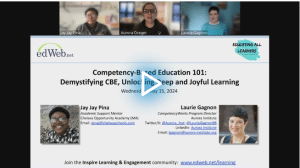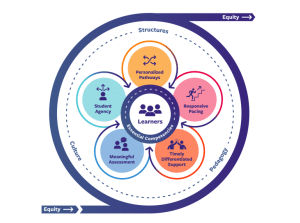Competency-Based Education 101: Demystifying CBE, Unlocking Deep and Joyful Learning
CompetencyWorks Blog
This week I had the opportunity to lead an edWeb webinar with Chelsea Opportunity Academy’s Jay Jay Pina, as a partner of the Educating All Learner’s Alliance. Competency-Based Education 101: Demystifying CBE, Unlocking Deep and Joyful Learning explored CBE in practice and entry points for shifting to a competency-based approach. Our goals were to:
- Share about what competency-based education is, why it’s important, and what policies are needed to enable the shift to CBE systems
- Share how educators and students in different settings across K-12 have approached the shift to CBE
- Reflect on what it means to center equity and joy in transforming the culture, pedagogy, and structure of K-12 schools and districts
On the CompetencyWorks blog, we share many stories of people doing the work to create full CBE systems or move specific CBE elements forward. As I was reflecting on the webinar, it occurred to me that sometimes we assume that we all know the why behind CBE. Even if we do, it feels worth it to revisit the foundations for CBE. In that spirit, I offer a recap to the question of why we need to change and why CBE offers an approach worth changing to.
Let’s start with WHY we need to shift
Sometimes it is helpful to take a step back and re-examine the structures that underlie the current education system, which operates in largely the same way as it did over 100 years ago. Our industrial system was designed to rank and sort students – to efficiently train factory workers, not to help every child thrive.
Why isn’t our status quo system aligned to our goals for all children to learn what they need to be successful?
First, it is based on time, rather than learning. In a set amount of time with a one-sized-fits all curriculum, kids move on regardless of what or how much they’ve learned. This means that kids advance with learning gaps because we allow students to move ahead with a 60% or 70%. And we don’t know what they missed or if it’s essential in learning the next thing.
To take an intuitive example from life, if the learning goal is riding a bike, what does it mean for my future if I only can ride a bike 70%?
Our traditional curriculum also narrowly focuses on the coverage and recall of academic knowledge. However, today’s learners need to be prepared for jobs that don’t yet exist. Numeracy and literacy are essential, AND students need skills like communication, critical thinking, collaboration, as well as social emotional skills.
We are accepting variable outcomes by design, and too often grading practices also obscure learning and support ranking and sorting students. Grades often average evidence of early attempts when a student is still learning, which keeps us from seeing the level of competence demonstrated in the end. Grades average evidence of learning with behaviors like raising your hand and completing homework on time. Even for the top performers, they are often focused on doing school to get the A, rather than learning.
Jay Jay Pina shared her own experience in the traditional system before being in the first group of students to learn at Chelsea Opportunity Academy.
Speaking to one-size-fits-all, I came from a traditional setting and then went to a CBE school. From what I can remember from that time in my academic career, was that it was just torture for me. I always felt I was very far behind. Even though I was moving forward in some things, I didn’t feel like I knew all of the material. I felt that there was more for me to learn and know to apply. I never really felt ready for the next stage in anything, which was really a concern. There are definitely some changes when it comes to this system and the way it works.
We can reimage our education system.
We need learners prepared with knowledge, skills and dispositions to thrive in an increasingly global and complex world. CBE is about learners being engaged and having a say in their learning. Learning is something the learner does, it isn’t done to them and isn’t about compliance.
Learning also happens in a variety of settings, not just in a classroom. When we are clear on the learning goals, we have more flexibility on how to get there. Deep learning requires application of knowledge and skills in meaningful ways with real world products and communication to real audiences.
The Aurora seven-part definition of competency-based education incorporates the research from the learning sciences. It meets students where they are. The learner is at the center of an equity-seeking system guided by a shared vision grounded in a belief that all learners can learn and thrive. Working toward equity means working to ensure equally high outcomes for all participants in our educational system; removing the predictability of success or failures that currently correlates with any social or cultural factor. We must:
- Create cultures of belonging,
- Ensure our structures interrupt inequitable practices, and
- Implement culturally responsive pedagogies that discover the unique gifts, talents and interests that every human possesses.
Making this shift is not one-size-fits-all for schools, just as it isn’t one-size-fits-all for learners.
A coherent and equitable CBE system requires an inclusive process and a learning orientation in which all stakeholders share the vision and collaborate to achieve it.
Fundamentally, CBE’s big shift is to design around what students have learned, not just how much time they spent in school. Essential competencies are clear and we help learners get to competence so that they gain confidence in their ability to learn new things and use what they learn.
The 5 circles around the learner describe the practices that support students in learning the essential competencies.
- Students learn how to learn and their agency is encouraged and developed. They know what they are learning.
- Assessment is meaningful and generates the evidence needed to know where learners are in their learning.
- That information is used to provide supports that meet learners where they are in their academic learning and as whole humans.
- CBE allows learners to move on when they are ready – as they grow, they are ready for what’s next. The pacing is responsive to their learning, not just the passage of time.
- Learning pathways are flexible, allowing students to learn through their interests and what is relevant.
Each of these elements can be worthy of focus on its own. And, we believe that in a coherent CBE system, these practices are greater than the sum of their parts and can transform our system to be truly equitable.
I recommend checking out the recording if you didn’t have a chance to join and keeping it in mind as a resource for people wanting to know more about CBE. Participants had a positive experience and here are a few of their reflections.
- Hearing from somebody who just graduated from a CBE school and is now a mentor, is great.
- This presentation fanned the flames of my passion to see change in education that will cater to individual student needs/pacing and truly benefit society. CBE would help eliminate learning gaps and reignite passion for learning!
- Very well organized and gave insightful information that stayed on topic. Can’t wait to incorporate CBE in my school.
- So many great examples, not just talking about this work from a theoretic level. Loved the video and curating names of many schools that are doing this work!!
- This concept just makes so much more sense than the current one. It makes all students feel empowered, instead of defeated.
- Even though it sounds impossible to apply the CBE approach in my school in its entirety, I know I can try to promote this in my classes.
I’d love to hear how you explain the WHY for CBE in your setting. What helps you explain CBE to students, educators, families, and your broader community?

